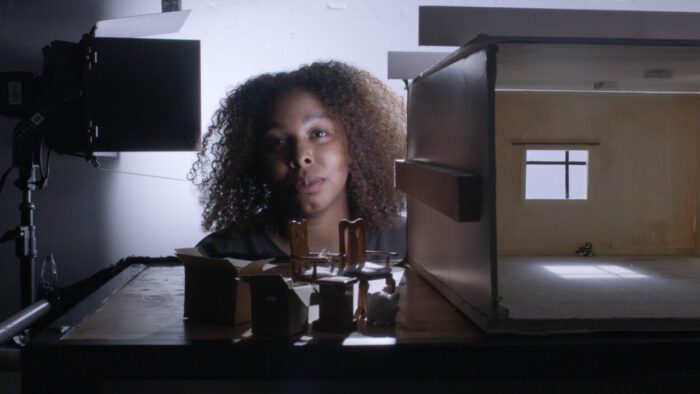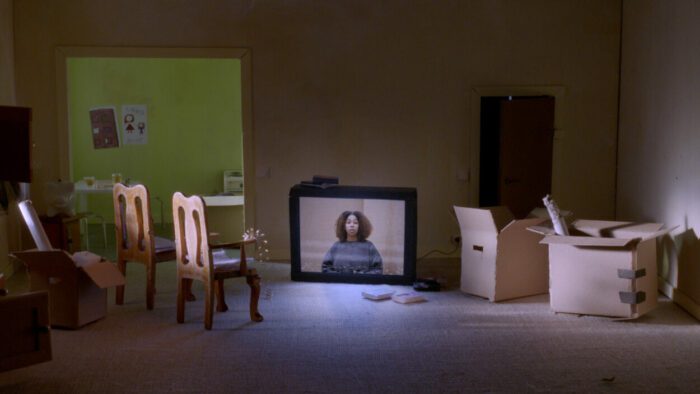How best to explore and convey the emotional cost of increased economic inequality? Documentary director Signe Rosenlund-Hauglid has a unique perspective on the matter in her entrancing, enlightening short film “A Home on Every Floor”: by mixing spoken-word poetry and a re-enactment constructed in a world of miniatures.
It’s an unusual approach, but it’s both immersive and inventive. In “A Home on Every Floor,” poet and social geographer Hanna Asefaw, who grew up in a municipal flat in Oslo with her Eritrean family in the late ’90s, revisits a reconstruction of her childhood universe, reflecting on the community she once knew there in a spoken word performance. Asefaw haunts that miniaturized apartment complex like a contemporary ghost, having, from her adult perspective, born witness to the neoliberalist policies that led to its demise. Mixing nostalgic sentiment and righteous resolve, “A Home on Every Floor” and the narration that guides it protest the decimation of lower-income housing across Oslo and other cities.
Signe Rosenlund-Hauglid (b. 1995) is a journalist and filmmaker with an MFA in creative directing from HDKValand in Gothenburg who works in both fiction and documentary. “A Home on Every Floor” won Best Nordic Film at Minimalen Short Film Festival and the Spark Award at The Norwegian Short Film Festival. Rosenlund-Hauglid recently spoke with Film Obsessive publisher J Paul Johnson on the production and themes of “A Home on Every Floor.” The transcript following the video below has been edited for clarity and space.
Film Obsessive: Signe, welcome! Can I have you do a brief introduction to what your film is and what it does?
Signe Rosenlund-Hauglid: Thank you so much. That’s a very kind introduction. “A Home on Every Floor” is a short documentary that explores childhood and memories—not in a normal way, but we’ve tried to explore some new cinematic methods. It’s based on a poem written by a poet called Hanna Asefaw, and she lives here in Oslo, where I’m also based, and it’s about her upbringing in a communal housing complex in Grenka, which used to be the workers area in the city and now it’s completely gentrified.

So it’s basically about upbringing and sort of the good and bad things that can happen in social housing. And I really wanted to make this film because the stories that are written about social housing usually see it as a place for people with difficulties in Norway. And Hanna really, really drew me in when I heard her text for the first time, and I felt like she really, really described everything that constitutes a home. Even though you know your neighbors have problems, it can still be a really wonderful upbringing. So I love the balance between, and that’s why I wanted to make the film.
It’s such a unique approach. Perhaps it’s not unprecedented to mix different styles in a film that we might or might not call documentary—and I want to get more into that—but let’s just focus on Hanna, your subject for a minute. She’s a poet, and you said that the film’s narrative, is it a poem of hers? Can we call it that—like is it a poem? Is it adapted from a poem, or is it a performance of her poetry? How would you characterize that?
Well, it’s definitely her poem. And she wrote it years before we made this film. So she didn’t write it to make a film in that sense. And she does spoken word. So her poems are usually heard and experienced and not read. And so I saw her perform this poem during a festival in 2020, it was the summer and the lockdowns had sort of opened up a bit, so we were allowed to go out for a bit. And yes, I would say the film is an adaption of Hanna’s poem. And it’s taken some artistic freedoms or how you would say it in English. But we’ve used the poem and bent it even further in the sense that we’ve recreated this universe that she’s describing.
But it’s not documentary in the sense that you try to make everything exactly the way it was. It’s more bringing the audience into an idea of these lives that Hanna is describing or the rooms that these people lived in. And I think you call them dioramas in the US, but we call them miniatures. So we sort of built a miniature of the housing complex that Hanna grew up in to film. And there are other filmmakers who have done that as well. I don’t know if you’ve seen the feature film, Mother of All Lies. It’s by a Moroccan filmmaker called Asmae El Moudir. She does the exact same thing. And that film was also sort of released at the same time as ours, so I hadn’t seen that. But I’ve seen the use of miniatures in art. There are several artists who’ve used it to work with memory and It’s an easy, cheap way of getting into rooms that you can’t enter because of a variety or a myriad of other reasons.
And it was just a lot of fun!

The approach is fascinating to me. First of all, in that you were working with subject matter that is not normally the province of documentary filmmaking does not normally begin in poetry. There’s no rule that says it can’t. But it seems like that’s more the exception than the rule. When you’re doing that, it would seem to warrant an approach that is at least unconventional.
Here in a way, it’s kind of a reenactment, except that you don’t have figures inside your miniatures. It’s all narrated from Hanna’s perspective. So I’m just wondering if you could talk a little bit about what you’re choosing to do as a director to animate and bring to life the essentially static diorama or miniature.
Yeah, that was a huge challenge, actually, bringing everything to life. I come from a background of more traditional documentary. I’ve done, you know, the fly on the wall thing, and I’ve done reconstructions with actors, and I’ve tried a lot of different things. And the idea here was that what Hanna is describing is real. It’s a real problem. Like social housing—there’s less and less of it. And the housing policies in Norway are very, very based on survival of the fittest. We have one of the most neoliberal housing markets in Europe. So it’s really, really hard to get into the housing market, and that sort of creates this group of people like Hanna being moved further and further out of the city center.
So the text has this sense of realness in addition to being Hanna’s experience. But I’m really interested in point of view when working with other people’s stories and knowing that Hanna grew up in this housing complex when she was quite young. I didn’t want to present this as the story of this building. There were tons of other people in that building in that time that didn’t contribute to this project. So [I came up with] the idea of making this diorama or miniature of the building and make Hanna be the one interrupting in the images. She’s moving boxes and looking in windows. It underlines the fact that this is indeed Hanna’s story, and it’s her view of her own upbringing.
We had a lot of different tests where we worked with the miniatures are built in this [medium], it’s called Pappmasjé in Norwegian. You understand?
I do! My mother was actually a papier-mâché artist for many years!
Okay, cool. So it’s it’s a material that it’s easy to change. When it’s put together, you could always change it and paint, repaint, do other things. And one decision I took quite early when we started shooting was that almost every image had to have some sense of life. And that could be some wind in a curtain, or it could be the TV running in the background, or it could be, you know, some tiny thing that would have to happen in the image or the cigarettes in the boxes that have smoke coming out. And that was just because nothing happened in the images. Some of them, Hanna was like moving in and out and looking in different directions or putting things moving things. But apart from that, it wasn’t much action, and that’s hell when it comes to editing! You know, there’s no progress.
So we worked a lot with sound design in this film to make it come alive and to make it feel like a community and an apartment building and create the sounds of the city, create the sound of the neighbors, and that specific neighbor that made those sounds, and you have to have all these different sounds of life in the scenery that’s very static. There’s music and a lot of pans up and down and back and forth to keep it flowing in a sense visually.
I will just say as a viewer, it’s really it’s a lovely and engrossing experience. I mean, it’s simultaneously very immersive, but at the same time, you’re constantly breaking that immersion with Hanna’s presence as a narrator, if you will, and peeking through the windows and sliding into view. I really can’t think of anything quite like it. Did something prepare you for this? As you’re going through your education and your classes, and you said you’re trained in documentary, did you experience things that led you at this point in your life to direct a documentary that would employ miniatures and animation and an external narrator?
Yes, well, I think it was a bit of a coincidence. There are two things, I would say. One was Corona. We were stuck in our homes a lot. So you know, it makes you think about your home a lot more. You sort of noticed the stuff that you put on the wall and you rearranged and so many people painted during COVID because, you know what else was there to do?
And the other thing is that I watched a few of the short films of this Swedish director animator called Niki Lindroth von Bahr. She’s made a series of shorts called The House on Netflix. She’s quite big in Sweden, and she has these amazing animations. And there’s a lot of humor. The entire world is built by her, and it’s animations. So that sort of differs from us. And I think the reason why this happened was because the apartment building that Hanna grew up in, it exists. It’s in Oslo. It’s not far away from where I live, but it was under construction. So there was no way we were going to go in there and film anything.
And I worked with a very, very good production designer called Julia Jayko Fossland, and she had done something similar in theater in Norwegian theater play a few years earlier. So she was the one who had the idea of building this [miniature set], and we were quite dependent on her for the success of how things worked because she built everything from scratch. And she also came up with sketches and ideas.

So it was a lot of coincidences, but also I remember going into the studio when we had our test day shooting with just blank miniatures, no paint, no detail, no nothing. And just having Julia, the production, come in and out of the frame and like and I just I just saw that there was something there. It just worked in a sense. And what’s so nice when you work with miniatures is also that it’s so easy to control. You have maximum control of everything that’s happening in the image. So it’s a bit like a director’s dream, you know, coming from classic documentary.
Where you don’t have to worry about people wandering into the range!
No. No. Or things are out of focus, or people talk and you don’t have the mic on them yet. You know, that kind of thing. That’s the complete opposite. So I just loved sort of going into this project and also developing it during COVID. We had a lot more time than we would usually have. And just working on detail and working on every room and what was going to be and each room symbolizes a character in Hanna’s poem. So we worked with their story with Hanna’s childhood photos, with different sort of looks and styles, and how it would work on camera, which camera we should use, how we should film it.
It was a lot of fun, actually! And when we got there, even though the production design is a bit rough—it’s not like, you know, anything fancy—it just felt like it all kind of came together.
And now it’s been out in front of an audience.
Yes. It’s been in the festival run for about a year. We premiered last June at the Norwegian Short Film Festival in Grimstad. Since then it’s been several festivals: Doc NYC in the fall, Slamdance in Utah. And the last big festival we went to in North America was Hot Docs festival in Toronto. It’s been going really, really well, and that’s been so much fun. And it’s a low budget film. There’s a lot of heart in it. So many people have contributed.
So I was also a bit like, you know, it’s a Norwegian film, where all dialogue is in Norwegian. It only has subtitles. I just want it to reach beyond our borders. But it obviously has touched some kind of nerve about a topic that’s relevant to many people.
And it’s a topic that, even though it’s grounded in your observation and Hanna’s specific experience in Oslo, is going to speak to people universally. I mean, people in our country are facing similar kinds of crises of escalating rents everywhere, very few opportunities for homeownership, especially for people of your generation moving forward into adulthood and careers. And I’m sure they’re going to be very, very touched by its message. We also have the same dilemma of corporate ownership of residential housing that’s really had a deleterious effect on the market here as well.
I don’t know if you’ve seen the Swedish documentary called Push. It’s made by a director called Fredrik Gertten. It was all around the world in 2018-19. And I think housing is, at least here, we say that housing is the key driver of economic inequality or the housing policies. So housing is just the foundation for life. And I think if we make a better housing policy, we can also solve a lot of other problems. You know, it can be addiction to drugs, it can be crime, it can be so many things if people actually have the chance to have a home and not just buy homes.
People can buy homes, sure, but just to have a home that’s a stable home in a neighborhood that feels good to live in and a sense of community, at least. That’s also a really important part of the film, the sense of community they created, even though they were all in low income housing. I feel like that’s just something our politicians have forgotten about because here’s a lot of money in housing. And we’ve created a system where we allow certain people or very few people to own a lot of homes. Then they also hold a lot of power over people’s lives. And they can dictate the market. Ivar Tollefson, the guy who bought up Hanna’s old childhood home, he owns 160,000 apartments across ten countries. That’s why would anyone want that? What’s the point? Why do we allow this to happen?
It’s up to artists like yourself and Hanna to protest that, of course, and to draw attention to the problem with your work. And thank you for doing that. Do you see yourself doing more work in this vein in the future?
Yeah, I really loved it. We’re working on a second film with Hanna now.
That’s exciting!
It’s a very different subject. I’m not going to say too much yet, but there’s going to be more in the miniature style.
I’m excited to see it, Signe. I love your film very much, and I just want to say, thank you so much for taking the time to speak with us today, and we all look forward to seeing “A Home on Every Floor” and your future work in the days and years to come.
Thank you. Thank you so much.



